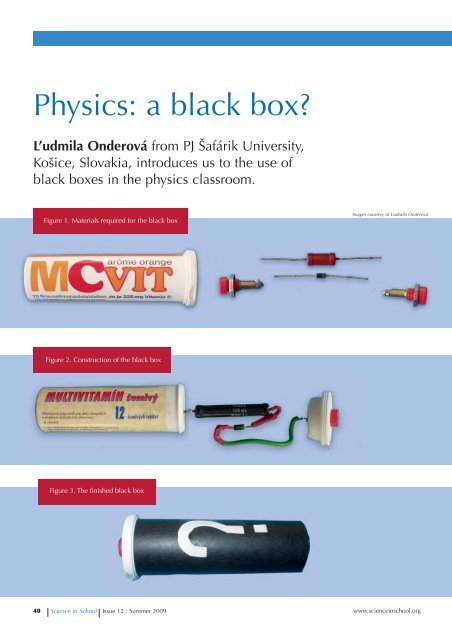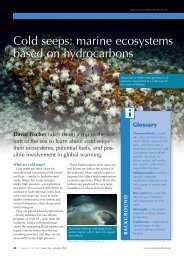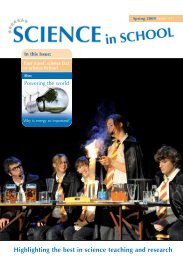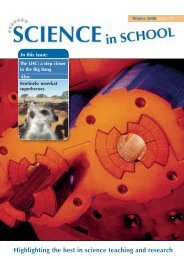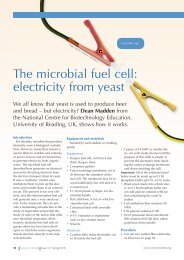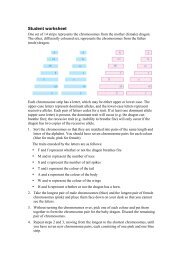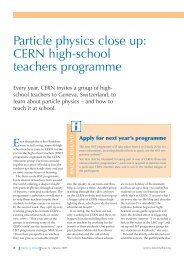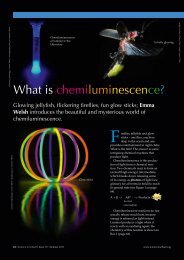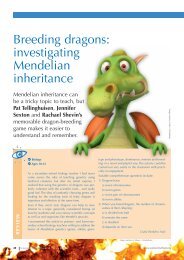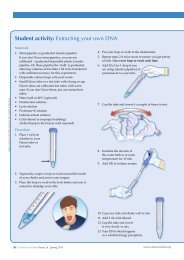Physics: a black box? - Science in School
Physics: a black box? - Science in School
Physics: a black box? - Science in School
Create successful ePaper yourself
Turn your PDF publications into a flip-book with our unique Google optimized e-Paper software.
<strong>Physics</strong>: a <strong>black</strong> <strong>box</strong>?<br />
L’udmila Onderová from PJ Šafárik University,<br />
Košice, Slovakia, <strong>in</strong>troduces us to the use of<br />
<strong>black</strong> <strong>box</strong>es <strong>in</strong> the physics classroom.<br />
Figure 1. Materials required for the <strong>black</strong> <strong>box</strong><br />
Images courtesy of L’udmila Onderová<br />
Figure 2. Construction of the <strong>black</strong> <strong>box</strong><br />
Figure 3. The f<strong>in</strong>ished <strong>black</strong> <strong>box</strong><br />
40 <strong>Science</strong> <strong>in</strong> <strong>School</strong> Issue 12 : Summer 2009<br />
www.science<strong>in</strong>school.org
Teach<strong>in</strong>g activities<br />
The idea beh<strong>in</strong>d us<strong>in</strong>g a <strong>black</strong> <strong>box</strong><br />
<strong>in</strong> the classroom is for students<br />
to try to figure out its contents – prepared<br />
<strong>in</strong> advance by the teacher –<br />
without open<strong>in</strong>g it. Once they have<br />
experimentally determ<strong>in</strong>ed what is<br />
<strong>in</strong>side, the students can open the <strong>box</strong><br />
to verify their hypothesis. An example<br />
of how to use <strong>black</strong> <strong>box</strong>es to teach<br />
electric circuits, suitable for students<br />
aged 15-18, is described below.<br />
However, there are many possible<br />
uses for <strong>black</strong> <strong>box</strong>es <strong>in</strong> the classroom,<br />
also for younger students and <strong>in</strong><br />
other areas of physics w1 .<br />
I’ve had good experiences us<strong>in</strong>g this<br />
method both <strong>in</strong> the classroom and <strong>in</strong><br />
the education of future physics teachers.<br />
Many teachers don’t seem to be<br />
familiar with it, yet it is actually very<br />
similar to problems you have to solve<br />
<strong>in</strong> real life. Besides, the experiment fosters<br />
the creativity of students, and<br />
<strong>black</strong> <strong>box</strong>es are cheap and easy to<br />
build.<br />
Build<strong>in</strong>g the <strong>black</strong> <strong>box</strong><br />
Materials<br />
· A plastic pill tube (e.g. from effervescent<br />
vitam<strong>in</strong> C)<br />
· A drill<br />
· Two banana jacks (e.g. the plugs on<br />
the cables connect<strong>in</strong>g the amplifier<br />
to the loudspeakers <strong>in</strong> a hi-fi sound<br />
system)<br />
· Electronic components (e.g. resistors,<br />
capacitors, diodes, etc.) to fit<br />
<strong>in</strong>side the tube<br />
· Flexible l<strong>in</strong>e wires<br />
Procedure<br />
· Drill a hole <strong>in</strong>to each end of the<br />
tube.<br />
· Push the banana jacks through the<br />
holes.<br />
· Connect the electronic component(s)<br />
to the jacks us<strong>in</strong>g the wires<br />
(see Figure 2).<br />
· Fit it all <strong>in</strong>side the tube, and<br />
close it.<br />
A removable tube top and flexible<br />
wires make it easy to reveal the components<br />
and the circuit <strong>in</strong>side the<br />
<strong>black</strong> <strong>box</strong>. You should make sure that<br />
the connection of elements <strong>in</strong>side the<br />
<strong>box</strong> is simple and easy to detect for<br />
the students. The outside appearance<br />
of the <strong>box</strong> is up to you; I wrap the<br />
tubes with a sheet of <strong>black</strong> paper.<br />
You can create <strong>black</strong> <strong>box</strong>es of different<br />
complexity – some of them enclos<strong>in</strong>g<br />
only one electronic component<br />
(resistor, capacitor, diode, coil, etc.),<br />
others conta<strong>in</strong><strong>in</strong>g several components<br />
connected to form simple circuits (see<br />
Figure 4).<br />
Experiments with <strong>black</strong> <strong>box</strong>es<br />
Once students have been <strong>in</strong>troduced<br />
to the basics of DC and AC electric circuits,<br />
they can start experiment<strong>in</strong>g<br />
with <strong>black</strong> <strong>box</strong>es to apply what they<br />
have learned to the solution of a practical<br />
problem. They are given materials<br />
(listed below) to be used for determ<strong>in</strong>-<br />
Figure 4. Electrical circuits conta<strong>in</strong>ed <strong>in</strong> the <strong>black</strong> <strong>box</strong>es<br />
Image courtesy of L’udmila Onderová<br />
www.science<strong>in</strong>school.org <strong>Science</strong> <strong>in</strong> <strong>School</strong> Issue 12 : Summer 2009 41
<strong>in</strong>g the <strong>in</strong>dividual elements conta<strong>in</strong>ed<br />
<strong>in</strong> a <strong>black</strong> <strong>box</strong>. They are <strong>in</strong>formed <strong>in</strong><br />
advance about all possible <strong>in</strong>ternal<br />
configurations of the <strong>box</strong>es. In the first<br />
stage, each group of students receives<br />
five <strong>black</strong> <strong>box</strong>es conta<strong>in</strong><strong>in</strong>g only one<br />
electronic element per <strong>box</strong>. In the next<br />
stage (not necessarily <strong>in</strong> the same lesson),<br />
they receive eight <strong>black</strong> <strong>box</strong>es<br />
with either a simple or more complex<br />
configuration <strong>in</strong>side each one. Their<br />
task is to f<strong>in</strong>d out the contents us<strong>in</strong>g<br />
their experience and an algorithm they<br />
develop for analysis of the <strong>box</strong>es.<br />
Materials per group<br />
· Five numbered <strong>black</strong> <strong>box</strong>es conta<strong>in</strong><strong>in</strong>g<br />
<strong>in</strong>dividual electronic elements<br />
(resistor, coil, capacitor, diode,<br />
<strong>in</strong>sulator)<br />
· Eight numbered <strong>black</strong> <strong>box</strong>es conta<strong>in</strong><strong>in</strong>g<br />
both simple and more complex<br />
circuits (see Figure 4)<br />
Leads<br />
An ampere-meter<br />
A voltmeter<br />
A source of DC and AC voltage<br />
· A sketch of all possible <strong>in</strong>ternal<br />
configurations.<br />
Procedure<br />
1. Divide the students <strong>in</strong>to groups of<br />
2-3 students.<br />
2. Hand out all materials.<br />
3. Students have 30 m<strong>in</strong>utes to measure<br />
the five simple <strong>box</strong>es and<br />
determ<strong>in</strong>e their contents.<br />
4. Each group reports their results.<br />
5. Compare the results, and verify by<br />
open<strong>in</strong>g the <strong>black</strong> <strong>box</strong>es.<br />
6. If the hypothesis was wrong, determ<strong>in</strong>e<br />
where the mistake comes<br />
from. In my experience, students<br />
have a success rate of about 80%.<br />
They usually have trouble dist<strong>in</strong>guish<strong>in</strong>g<br />
a coil from a resistor, as<br />
they are usually satisfied with f<strong>in</strong>d<strong>in</strong>g<br />
that a <strong>box</strong> conducts electric current<br />
and don’t analyse its value.<br />
7. Try to set up an optimum algorithm<br />
to determ<strong>in</strong>e the elements <strong>in</strong><br />
the <strong>box</strong>. This is what a possible<br />
algorithm could look like:<br />
a) Set up an electric circuit consist<strong>in</strong>g<br />
of a <strong>black</strong> <strong>box</strong>, a voltage<br />
source, an ampere-meter and a<br />
voltmeter.<br />
b) Use a DC voltage source, connect<br />
the circuit, measure the current<br />
and the voltage, and write<br />
down the results.<br />
c) Change the polarity of the DC<br />
voltage source, measure the current<br />
and the voltage aga<strong>in</strong>, write<br />
down the results and compare<br />
them with the previous ones.<br />
d) Use an AC voltage source, measure<br />
the current and the voltage<br />
and compare the results with the<br />
two previous measurements.<br />
e) Propose a hypothesis about the<br />
structure of the <strong>black</strong> <strong>box</strong>.<br />
f) Verify the hypothesis by additional<br />
measurements.<br />
g) Determ<strong>in</strong>e the contents of the<br />
<strong>black</strong> <strong>box</strong>.<br />
8. Next, students have 40 m<strong>in</strong>utes to<br />
determ<strong>in</strong>e the contents of the eight<br />
simple and complex <strong>box</strong>es.<br />
9. Repeat the evaluation as before. In<br />
my experience, students f<strong>in</strong>d this<br />
task more difficult, and not all<br />
groups are able to determ<strong>in</strong>e the<br />
contents of all <strong>box</strong>es <strong>in</strong> the given<br />
time. The success rate is also lower,<br />
at about 70%. This is still a very<br />
good result, though, and would<br />
probably not be achieved if <strong>in</strong>dividual<br />
students were try<strong>in</strong>g to<br />
solve the task, rather than groups.<br />
In the second test, students tend to<br />
have problems not with determ<strong>in</strong><strong>in</strong>g<br />
simple elements, but with determ<strong>in</strong><strong>in</strong>g<br />
more complex circuits and dist<strong>in</strong>guish<strong>in</strong>g<br />
between a resistor, a thermistor<br />
and a bulb. They have to apply<br />
their theoretical knowledge and need<br />
to realise that it is necessary to change<br />
the voltage and, eventually, to draw a<br />
diagram to be able to determ<strong>in</strong>e the<br />
elements <strong>in</strong> the <strong>box</strong>es correctly.<br />
What value do students get from<br />
these experiments?<br />
Manipulat<strong>in</strong>g <strong>black</strong> <strong>box</strong>es is an<br />
attractive task for students to test their<br />
REVIEW<br />
This is an <strong>in</strong>terest<strong>in</strong>g activity<br />
to be performed with<br />
secondary-school students.<br />
It is useful to practise<br />
a range of concepts <strong>in</strong><br />
physics <strong>in</strong> a didactic way.<br />
Amador Menéndez<br />
Velázquez, Spa<strong>in</strong><br />
knowledge and enjoy their success.<br />
Some even try to f<strong>in</strong>d further opportunities<br />
to use this method <strong>in</strong> physics<br />
teach<strong>in</strong>g themselves. Most importantly,<br />
students learn to use a systematic<br />
method of <strong>in</strong>vestigation. The <strong>black</strong> <strong>box</strong><br />
experiment encourages students to ask<br />
and answer their own questions,<br />
express their predictions, test their<br />
hypotheses and communicate the<br />
results to their peers. Such an active<br />
method also helps to better understand<br />
the nature of science. In addition,<br />
this is also a good way to solve<br />
problems <strong>in</strong> real life, for example if<br />
you need to work out how a device<br />
(<strong>black</strong> <strong>box</strong>) works when you have lost<br />
the user manual.<br />
A critical po<strong>in</strong>t <strong>in</strong> sett<strong>in</strong>g the task is<br />
the amount of <strong>in</strong>formation given on<br />
the possible structure of the <strong>box</strong>’s contents.<br />
The teacher needs to ensure that<br />
the students have sufficient previous<br />
knowledge and to give clear <strong>in</strong>structions<br />
on how to proceed. Fewer<br />
<strong>in</strong>structions provoke more creative<br />
th<strong>in</strong>k<strong>in</strong>g, but if not enough <strong>in</strong>formation<br />
is provided, students may feel<br />
overburdened by the task and lose<br />
<strong>in</strong>terest.<br />
Web references<br />
w1 – For further examples of us<strong>in</strong>g<br />
<strong>black</strong> <strong>box</strong>es <strong>in</strong> physics teach<strong>in</strong>g, see:<br />
The optical <strong>black</strong> <strong>box</strong> on the <strong>Science</strong><br />
Olympics website:<br />
www.physics.uwo.ca/science_<br />
42 <strong>Science</strong> <strong>in</strong> <strong>School</strong> Issue 12 : Summer 2009<br />
www.science<strong>in</strong>school.org
Teach<strong>in</strong>g activities<br />
olympics/events/grades_9_to_10/<br />
optical_<strong>black</strong>_<strong>box</strong>.html<br />
The <strong>black</strong> <strong>box</strong> mystery on the<br />
<strong>Science</strong> Olympics website:<br />
www.physics.uwo.ca/science_olym<br />
pics/events/grades_9_to_10/<strong>black</strong>_<br />
<strong>box</strong>_mystery.html<br />
Two <strong>black</strong> <strong>box</strong> experiments (IphO<br />
2004 experimental question problem<br />
and IphO 2002 experimental<br />
question 2 problem) on the<br />
International <strong>Physics</strong> Olympiads<br />
website www.jyu.fi/ipho<br />
‘Archimedes: A Black Box<br />
Mechanics Laboratory’ on the website<br />
of Colgate University, USA:<br />
http://departments.colgate.edu/<br />
physics/research/<strong>Physics</strong>Ed/<br />
labs.htm<br />
from the 35 th International <strong>Physics</strong><br />
Olympiad. Resonance, 10(4): 75-82.<br />
www.ias.ac.<strong>in</strong>/resonance/Apr2005<br />
/pdf/Apr2005Classroom2.pdf<br />
Terry C (1995) Black-<strong>box</strong> electrical<br />
circuits. <strong>Physics</strong> Teacher 33: 386-387<br />
Ľudmila Onderová works at the<br />
Institute of <strong>Physics</strong>, Faculty of<br />
<strong>Science</strong>, at the PJ Šafárik University <strong>in</strong><br />
Košice, Slovakia, and is responsible<br />
for the education of aspir<strong>in</strong>g school<br />
physics teachers. Her ma<strong>in</strong> <strong>in</strong>terests<br />
are hands-on experiments and activities<br />
dedicated to develop<strong>in</strong>g creativity<br />
and process skills <strong>in</strong> students.<br />
Resources<br />
For further examples of us<strong>in</strong>g <strong>in</strong>vestigative<br />
methods <strong>in</strong> the science<br />
classroom, see:<br />
Tifi A, Natale N, Lombardi A (2006)<br />
Scientists at play: teach<strong>in</strong>g science<br />
process skills. <strong>Science</strong> <strong>in</strong> <strong>School</strong> 1:<br />
37-40.<br />
www.science<strong>in</strong>school.org/2006/<br />
issue1/play<br />
Tifi A, Natale N, Lombardi A (2006)<br />
Scientists at play: contraptions for<br />
develop<strong>in</strong>g science process skills.<br />
<strong>Science</strong> <strong>in</strong> <strong>School</strong> 2: 20-23.<br />
www.science<strong>in</strong>school.org/2006/<br />
issue2/play<br />
Further read<strong>in</strong>g on the use of <strong>black</strong><br />
<strong>box</strong>es <strong>in</strong> the classroom:<br />
Amato JC, Williams RE, Helm H<br />
(1995) A “<strong>black</strong> <strong>box</strong>” moment of<br />
<strong>in</strong>ertia apparatus. American Journal<br />
of <strong>Physics</strong> 63: 891-894<br />
Barney DM (1955) A “<strong>black</strong> <strong>box</strong>”<br />
laboratory assignment. American<br />
Journal of <strong>Physics</strong> 23: 546<br />
Burl<strong>in</strong>g RL (1957) Black <strong>box</strong>es <strong>in</strong> the<br />
<strong>in</strong>structional laboratory. American<br />
Journal of <strong>Physics</strong> 25: 492<br />
S<strong>in</strong>gh VA, Khaperde RB (2005) The<br />
mechanical <strong>black</strong> <strong>box</strong>: a challenge<br />
www.science<strong>in</strong>school.org <strong>Science</strong> <strong>in</strong> <strong>School</strong> Issue 12 : Summer 2009 43


